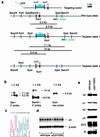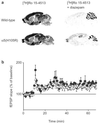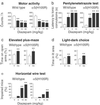Trace fear conditioning involves hippocampal alpha5 GABA(A) receptors
- PMID: 12084936
- PMCID: PMC124409
- DOI: 10.1073/pnas.142288699
Trace fear conditioning involves hippocampal alpha5 GABA(A) receptors
Abstract
The heterogeneity of gamma-aminobutyric acid type A (GABA(A)) receptors contributes to the diversity of neuronal inhibition in the regulation of information processing. Although most GABA(A) receptors are located synaptically, the small population of alpha5GABA(A) receptors is largely expressed extrasynaptically. To clarify the role of the alpha5GABA(A) receptors in the control of behavior, a histidine-to-arginine point mutation was introduced in position 105 of the murine alpha5 subunit gene, which rendered the alpha5GABA(A) receptors diazepam-insensitive. Apart from an incomplete muscle relaxing effect, neither the sedative, anticonvulsant, nor anxiolytic-like activity of diazepam was impaired in alpha5(H105R) mice. However, in hippocampal pyramidal cells, the point mutation resulted in a selective reduction of alpha5GABA(A) receptors, which altered the drug-independent behavior. In line with the role of the hippocampus in certain forms of associative learning, trace fear conditioning, but not delay conditioning or contextual conditioning, was facilitated in the mutant mice. Trace fear conditioning differs from delay conditioning in that the conditioned and unconditioned stimulus are separated by a time interval. Thus, the largely extrasynaptic alpha5GABA(A) receptors in hippocampal pyramidal cells are implicated as control elements of the temporal association of threat cues in trace fear conditioning.
Figures





Similar articles
-
GABA receptors containing the alpha5 subunit mediate the trace effect in aversive and appetitive conditioning and extinction of conditioned fear.Eur J Neurosci. 2004 Oct;20(7):1928-36. doi: 10.1111/j.1460-9568.2004.03642.x. Eur J Neurosci. 2004. PMID: 15380015
-
Time-dependent involvement of the dorsal hippocampus in trace fear conditioning in mice.Hippocampus. 2005;15(4):418-26. doi: 10.1002/hipo.20067. Hippocampus. 2005. PMID: 15669102
-
Alpha5GABAA receptors regulate the intrinsic excitability of mouse hippocampal pyramidal neurons.J Neurophysiol. 2007 Oct;98(4):2244-54. doi: 10.1152/jn.00482.2007. Epub 2007 Aug 22. J Neurophysiol. 2007. PMID: 17715197
-
The sedative but not the memory-blocking properties of ethanol are modulated by α5-subunit-containing γ-aminobutyric acid type A receptors.Behav Brain Res. 2011 Mar 1;217(2):379-85. doi: 10.1016/j.bbr.2010.11.008. Epub 2010 Nov 9. Behav Brain Res. 2011. PMID: 21070817
-
Hippocampal activity, but not plasticity, is required for early consolidation of fear conditioning with a short trace interval.Eur J Neurosci. 2007 Apr;25(8):2483-90. doi: 10.1111/j.1460-9568.2007.05493.x. Eur J Neurosci. 2007. PMID: 17445243
Cited by
-
Detoxification Improves Multidomain Cognitive Dysfunction in High-Dose Benzodiazepine Abusers.Front Neurosci. 2020 Jul 21;14:747. doi: 10.3389/fnins.2020.00747. eCollection 2020. Front Neurosci. 2020. PMID: 32848544 Free PMC article.
-
Extrasynaptic localization is essential for α5GABAA receptor modulation of dopamine system function.eNeuro. 2024 Feb 27;11(3):ENEURO.0344-23.2023. doi: 10.1523/ENEURO.0344-23.2023. Online ahead of print. eNeuro. 2024. PMID: 38413199 Free PMC article.
-
GABAA Receptors Are Well Preserved in the Hippocampus of Aged Mice.eNeuro. 2019 Aug 14;6(4):ENEURO.0496-18.2019. doi: 10.1523/ENEURO.0496-18.2019. Print 2019 Jul/Aug. eNeuro. 2019. PMID: 31340951 Free PMC article.
-
Molecular mechanisms of general anesthesia.Korean J Anesthesiol. 2010 Jul;59(1):3-8. doi: 10.4097/kjae.2010.59.1.3. Epub 2010 Jul 21. Korean J Anesthesiol. 2010. PMID: 20651990 Free PMC article.
-
Alterations in GABAA-Receptor Trafficking and Synaptic Dysfunction in Brain Disorders.Front Cell Neurosci. 2019 Mar 7;13:77. doi: 10.3389/fncel.2019.00077. eCollection 2019. Front Cell Neurosci. 2019. PMID: 30899215 Free PMC article.
References
-
- Cobb S R, Buhl E H, Halasy K, Paulsen O, Somogyi P. Nature (London) 1995;378:75–78. - PubMed
-
- Whittington M A, Traub R D, Jeffreys J G. Nature (London) 1995;373:612–615. - PubMed
-
- Gupta A, Wang Y, Markram H. Science. 2000;287:273–278. - PubMed
-
- Tamas G, Buhl E H, Lorincz A, Somogyi P. Nat Neurosci. 2000;3:366–371. - PubMed
-
- Wallenstein G V, Eichenbaum H, Hasselmo E. Trends Neuosci. 1998;21:317–323. - PubMed
Publication types
MeSH terms
Substances
LinkOut - more resources
Full Text Sources
Other Literature Sources
Molecular Biology Databases
Research Materials

